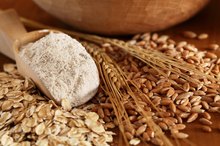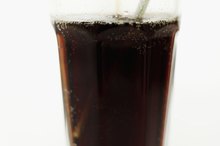Difference Between Meal Replacement & Protein Shake
Meal replacements and protein shakes can both support your body composition and athletic performance goals, although they do have significant differences in nutritional profile and benefits. While exact nutritional specifications differ between brands, many products share the same general characteristics, so choosing whether a protein shake or a meal replacement is more appropriate can be somewhat simple. Consult a doctor prior to using any supplements, as they may have unwanted side effects.
Calories
Meal replacements are intended to be more filling and contain more calories than a protein shake. Although meal replacements are higher in calorie than protein shakes, they tend to be lower in calories than actual meals, which can aid in dieting. Whey protein isolates tend to be the lowest calorie protein shakes, with 101 calories per serving, while others may contain about 120 calories. Meal replacement shakes typically contain between 250 and 400 calories.
Protein Content
Spelt Flour or Whole Wheat to Lose Weight?
Learn More
Protein shakes typically provide about 25 g of protein per serving, while the range of protein in meal replacements differs widely. Meal replacements intended for general health may be lower in protein, with 10 g per shake, while those intended for muscle building and dieting may contain up to 40 g. Protein provides muscle-building amino acids, but it may also aid in weight loss; a study from the October 2009 issue of "Nutrition, Metabolism and Cardiovascular Diseases" explains that high-protein diets may help you lose more weight and fat than lower protein meal plans.
Carbohydrate Content
Protein shakes typically have less than 5 g of carbohydrates, as they are not intended to be full meals. Meal replacement shakes tend to contain carbohydrates to make the nutritional profile more like a real meal. Meal replacements beneficial for dieting will contain dietary fiber, a nutrient that helps in digestion and makes you feel full, helping you consume fewer calories throughout the day.
Fat Content
Glucerna for Weight Loss
Learn More
Protein shakes are typically low in fat, with 3 g or fewer, while the fat content in meal replacements varies. Meal replacements that are lower in carbohydrates tend to be higher in fat, and may be useful for low-carbohydrate diets. Higher carbohydrate shakes tend to be lower in fat. You may wish to find a meal replacement containing omega-3 fats, as research from the October 2010 edition of the "Journal of the International Society of Sports Nutrition" suggests it may aid in fat loss and muscle gain.
Vitamins and Minerals
Protein shakes tend not to contain any added vitamins and minerals other than those provided by the protein source. For example, shakes made from whey protein, a dairy product, provide calcium. Although not all meal replacements contain added vitamins and minerals, many do.
Related Articles
References
- "Nutrition, Metabolism and Cardiovascular Diseases"; High Protein Diets Decrease Total and Abdominal Fat and Improve CVD Risk Profile in Overweight and Obese Men and Women With Elevated Triacylglycerol; P.M. Clifton et al.; October 2009
- MedlinePlus; Dietary Fiber; May 2011
- "Journal of the International Society of Sports Nutrition"; Effects of Supplemental Fish Oil on Resting Metabolic Rate, Body Composition, and Salivary Cortisol in Healthy Adults; E.E. Noreen et al.; October 2010
Writer Bio
Brian Willett began writing in 2005. He has been published in the "Buffalo News," the "Daytona Times" and "Natural Muscle Magazine." Willett also writes for Bloginity.com and Bodybuilding.com. He is an American Council on Exercise-certified personal trainer and earned a Bachelor of Arts in journalism from the University of North Carolina.









